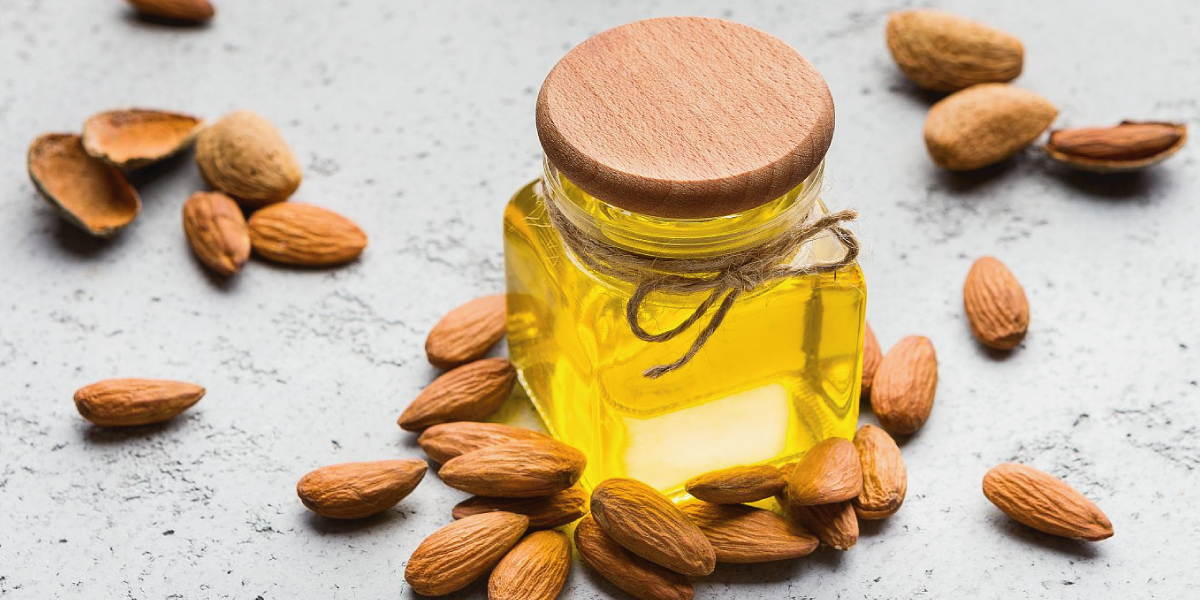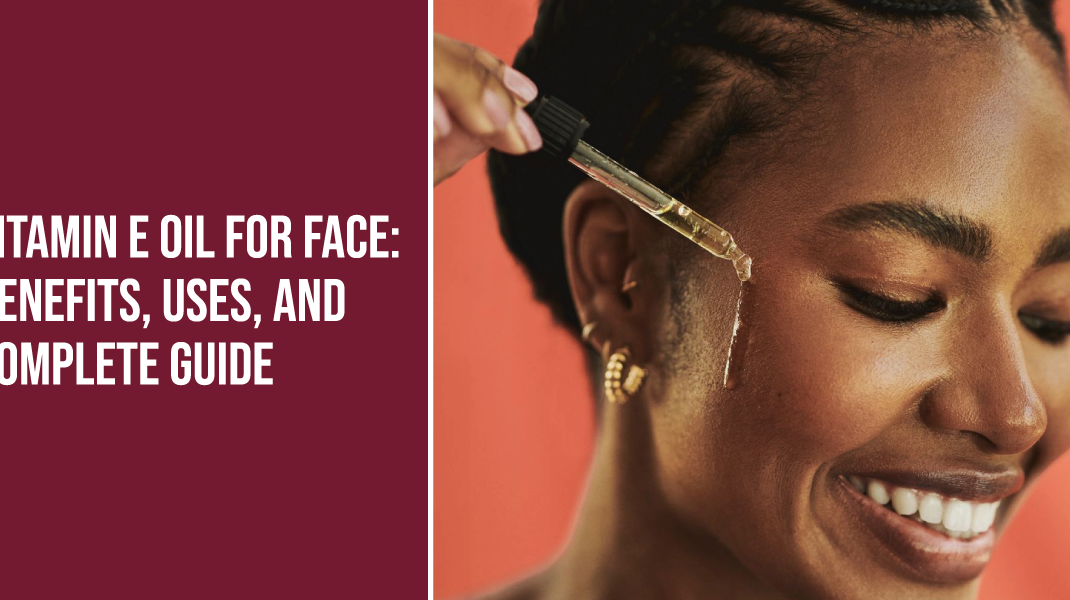Glowing and youthful skin is something many people dream of achieving. In recent years, vitamin E oil for face has become one of the most recommended natural remedies in skincare. This oil not only hydrates but also heals, protects, and slows down the aging process. From reducing wrinkles to fading scars, Vitamin E oil offers a wide range of benefits when used correctly.
This detailed guide will explore
- what Vitamin E oil is,
- how it benefits the skin,
- the correct methods of application,
- potential side effects,
and whether Vitamin E oil or Vitamin E capsules are better for your skincare routine.
What is Vitamin E Oil?

Vitamin E is a fat-soluble nutrient with powerful antioxidant properties. It protects the skin from free radicals, which are unstable molecules that damage skin cells and speed up aging. Free radicals are often caused by pollution, UV rays, stress, and unhealthy habits. When Vitamin E oil is applied to the face, it helps neutralize these harmful effects and allows the skin to heal and renew itself naturally.
The oil can be obtained from natural sources such as almonds, sunflower seeds, and wheat germ or produced synthetically for cosmetic use. Because of its thick and rich consistency, Vitamin E oil is often found as an ingredient in serums, moisturizers, and creams. Many people also apply the oil directly to the skin or extract it from Vitamin E capsules for topical use.
The 10 Proven Benefits of Vitamin E Oil for Your Face

The benefits of using vitamin E oil on your face are extensive and well-documented. It’s not just a single-purpose ingredient; it’s a versatile solution that can transform your complexion. Let’s explore the top ten ways this powerful oil can benefit your skin.
1. Powerful Antioxidant Protection
As mentioned, vitamin E’s primary role is as an antioxidant. It creates a defensive shield against oxidative stress. When paired with vitamin C, another powerful antioxidant, it boosts sun protection and helps to repair existing damage, making it a crucial part of any morning or night routine.
2. Anti-Aging and Wrinkle Reduction
One of the most popular uses of vitamin E oil for face is for its anti-aging properties. By fighting off free radicals that cause the breakdown of collagen, it helps to preserve the skin’s firmness and elasticity. Regular application can help soften the appearance of fine lines and wrinkles, giving your skin a smoother, more youthful texture.
3. Fading Acne Scars and Dark Spots
Vitamin E is renowned for its ability to help repair and regenerate damaged skin. This makes it an excellent choice for fading stubborn acne scars and dark spots caused by hyperpigmentation. It works by promoting skin cell renewal and improving the overall texture of the skin. For best results, consistency is key. A small and nightly application on the affected areas can make a significant difference over time.
4. Intense Hydration and Moisture
For those with dry or flaky skin, vitamin E oil is a game-changer. It is a fantastic emollient, meaning it helps to lock moisture into the skin. When applied, it creates a protective barrier on the surface. It prevents water loss and keeps your skin feeling soft, plump, and deeply hydrated.
5. Soothing Sunburns
After a day in the sun, your skin may feel hot, tight, and inflamed. Vitamin E’s anti-inflammatory properties can provide instant relief. It helps to calm the redness and discomfort of a sunburn while aiding the healing process.
6. Treating Hyperpigmentation
Uneven skin tone is a common concern, and vitamin E can help. By accelerating the turnover of skin cells, it assists in lightening dark spots and evening out overall skin tone, giving you a more uniform and radiant complexion.
7. Reducing Under-Eye Circles
While it’s not a miracle cure, the regenerative properties of vitamin E can help improve the appearance of dark circles. Improving blood circulation and reducing inflammation in the delicate under-eye area can make the skin look brighter and more rested.
8. Calming Inflamed Skin
If you suffer from inflammatory skin conditions like eczema or psoriasis, vitamin E can provide much-needed relief. Its soothing and moisturizing properties help to reduce redness, itchiness, and irritation, making it a gentle and effective addition to your skincare regimen.
9. Promoting Collagen Production
Collagen is the protein that provides structure and firmness to your skin. As we age, our natural collagen production declines. By protecting the skin from free radical damage, vitamin E indirectly helps to preserve existing collagen and can even encourage its production, keeping your skin firm and bouncy.
10. Overall Skin Barrier Support
Your skin’s barrier is its first line of defense against the outside world. When this barrier is compromised, your skin becomes vulnerable to dryness, irritation, and environmental damage. Vitamin E helps to fortify this barrier, making your skin stronger, more resilient, and better able to retain moisture.
How to Properly Use Vitamin E Oil on Your Face

While the benefits are clear, it’s essential to use vitamin E oil correctly to avoid any potential side effects. Here’s a simple, step-by-step guide on how to incorporate it into your routine.
Step 1: The Patch Test
Before applying vitamin E oil to your entire face, always perform a patch test. Apply a small amount to a discreet area, like behind your ear or on your inner arm. Wait 24 hours to check for any redness, irritation, or an allergic reaction. This is especially important for those with sensitive or acne-prone skin.
Step 2: Choose the Right Product
Vitamin E oil comes in many forms. You can find pure vitamin E oil in a bottle, or you can use the liquid from a vitamin E capsule by pricking it with a needle. You should also check the ingredients list on products.
Here’s a quick table to help you understand the different types:
| Type | How to Identify | Pros | Cons |
| Natural Vitamin E | Listed as d-alpha-tocopherol | More potent and bioavailable for skin | Can be more expensive; thicker consistency |
| Synthetic Vitamin E | Listed as dl-alpha-tocopherol | Less expensive; often found in many creams | Less effective for skin absorption |
For the best results, look for pure d-alpha-tocopherol in a dark glass bottle, which protects it from light degradation.
Step 3: Cleansing Your Face
Always apply vitamin E oil to a clean, dry face. This allows the oil to penetrate your skin effectively without any dirt or impurities getting in the way.
Step 4: Application Techniques
Vitamin E oil is quite thick and heavy, which is why it’s often recommended for overnight use.
- For Nighttime Treatment: After cleansing and toning, take just a few drops of the oil or the liquid from a capsule. Gently massage it into your face in upward, circular motions until it is fully absorbed.
- Mixing with Other Products: If you find it too thick on its own, you can mix a few drops with your regular nightly moisturizer or a lighter carrier oil like jojoba, almond, or argan oil. This makes it easier to spread and can reduce the risk of it feeling too heavy.
- Targeted Treatment: For fading specific scars or dark spots, you can dab a small amount of the oil directly onto the targeted area with a cotton swab or your fingertip.
Side Effects and Precautions

While generally safe for most people, vitamin E oil is not without its risks, especially for certain skin types.
- Comedogenicity: It is a heavy, occlusive oil, which can be comedogenic, meaning it can clog pores. If you have oily or acne-prone skin, it’s crucial to use it sparingly and monitor your skin for breakouts.
- Contact Dermatitis: Some people may be allergic to vitamin E, which can lead to a rash or contact dermatitis. This is why the patch test is a non-negotiable first step.
- Avoid on Active Acne: Applying heavy oils to inflamed, active acne can trap bacteria and worsen breakouts. It’s best to use it for treating old scars once the acne has cleared.
Who Should Use Vitamin E Oil on Face?
Vitamin E oil is most suitable for individuals with dry, dull, or mature skin. It is also helpful for people struggling with scars, pigmentation, or uneven skin tone. However, it may not be ideal for those with oily or acne-prone skin. Because the oil is thick and heavy, it can clog pores and potentially worsen breakouts. This is why a patch test is always recommended before using Vitamin E oil directly on the face.
Possible Side Effects of Vitamin E Oil
Despite its many benefits, Vitamin E oil is not without side effects. Some people may experience allergic reactions such as redness, itching, or a rash. Those with oily or sensitive skin may notice breakouts or clogged pores when using the oil. Additionally, applying too much Vitamin E oil at once can leave the skin feeling greasy and heavy. To avoid these issues, it is best to use Vitamin E oil two to three times a week and to apply it in moderation.
Final Thoughts
Vitamin E oil for face is a natural and effective solution for achieving soft, healthy, and glowing skin. It nourishes the skin deeply, fights free radicals, and helps in reducing scars, dryness, and signs of aging. Regular use of Vitamin E oil can improve skin elasticity, hydration, and overall radiance. To get the best results, apply it correctly in small amounts, patch test before use, and include it as part of a consistent skincare routine. Embrace Vitamin E oil for face today to naturally enhance your skin’s health and glow.

